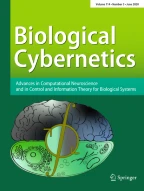Abstract
A neural network model for a mechanism of visual pattern recognition is proposed in this paper. The network is self-organized by “learning without a teacher”, and acquires an ability to recognize stimulus patterns based on the geometrical similarity (Gestalt) of their shapes without affected by their positions. This network is given a nickname “neocognitron”. After completion of self-organization, the network has a structure similar to the hierarchy model of the visual nervous system proposed by Hubel and Wiesel. The network consits of an input layer (photoreceptor array) followed by a cascade connection of a number of modular structures, each of which is composed of two layers of cells connected in a cascade. The first layer of each module consists of “S-cells”, which show characteristics similar to simple cells or lower order hypercomplex cells, and the second layer consists of “C-cells” similar to complex cells or higher order hypercomplex cells. The afferent synapses to each S-cell have plasticity and are modifiable. The network has an ability of unsupervised learning: We do not need any “teacher” during the process of self-organization, and it is only needed to present a set of stimulus patterns repeatedly to the input layer of the network. The network has been simulated on a digital computer. After repetitive presentation of a set of stimulus patterns, each stimulus pattern has become to elicit an output only from one of the C-cell of the last layer, and conversely, this C-cell has become selectively responsive only to that stimulus pattern. That is, none of the C-cells of the last layer responds to more than one stimulus pattern. The response of the C-cells of the last layer is not affected by the pattern's position at all. Neither is it affected by a small change in shape nor in size of the stimulus pattern.
Similar content being viewed by others
References
Fukushima, K.: Cognitron: a self-organizing multilayered neural network. Biol. Cybernetics 20, 121–136 (1975)
Fukushima, K.: Improvement in pattern-selectivity of a cognitron (in Japanese). Pap. Tech. Group MBE78-27, IECE Japan (1978)
Fukushima, K.: Self-organization of a neural network which gives position-invariant response (in Japanese). Pap. Tech. Group MBE 78-109, IECE Japan (1979a)
Fukushima, K.: Self-organization of a neural network which gives position-invariant response. In: Proceedings of the Sixth International Joint Conference on Artificial Intelligence. Tokyo, August 20–23, 1979, pp. 291–293 (1979b)
Fukushima, K.: Improvement in pattern-selectivity of a cognitron (in Japanese). Trans. IECE Japan (A), J 62-A, 650–657 (1979c)
Giebel, H.: Feature extraction and recognition of handwritten characters by homogeneous layers. In: Pattern recognition in biological and technical systems. Grüsser, O.-J., Klinke, R. (eds.), pp. 162–169. Berlin, Heidelberg, New York: Springer 1971
Gross, C.G., Rocha-Miranda, C.E., Bender, D.B.: Visual properties of neurons in inferotemporal cortex of the macaque. J. Neurophysiol. 35, 96–111 (1972)
Hubel, D.H., Wiesel, T.N.: Receptive fields, binocular interaction and functional architecture in cat's visual cortex. J. Physiol. (London) 160, 106–154 (1962)
Hubei, D.H., Wiesel, T.N.: Receptive fields and functional architecture in two nonstriate visual area (18 and 19) of the cat. J. Neurophysiol. 28, 229–289 (1965)
Hubel, D.H., Wiesel, T.N.: Functional architecture of macaque monkey visual cortex. Proc. R. Soc. London, Ser. B 198, 1–59 (1977)
Kabrisky, M.: A proposed model for visual information processing in the human brain. Urbana, London: Univ. of Illinois Press 1966
Meyer, R.L., Sperry, R.W.: Explanatory models for neuroplasticity in retinotectral connections. In: Plasticity and function in the central nervous system. Stein, D.G., Rosen, J.J., Butters, N. (eds.), pp. 45–63. New York, San Francisco, London: Academic Press 1974
Rosenblatt, F.: Principles of neurodynamics. Washington, D.C.: Spartan Books 1962
Sato, T., Kawamura, T., Iwai, E.: Responsiveness of neurons to visual patterns in inferotemporal cortex of behaving monkeys. J. Physiol. Soc. Jpn. 40, 285–286 (1978)
Author information
Authors and Affiliations
Rights and permissions
About this article
Cite this article
Fukushima, K. Neocognitron: A self-organizing neural network model for a mechanism of pattern recognition unaffected by shift in position. Biol. Cybernetics 36, 193–202 (1980). https://doi.org/10.1007/BF00344251
Received:
Issue Date:
DOI: https://doi.org/10.1007/BF00344251
